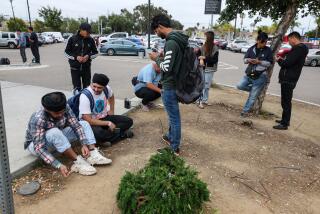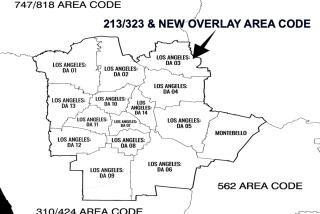Panel Debates Planned Overlay in 818 Area Code
- Share via
NORTH HOLLYWOOD — A public utilities commissioner warned Friday that legislation proposed by Assemblyman Wally Knox (D-Los Angeles) to scrap 11-digit dialing could leave consumers with only one option when their area codes get crowded--to split.
“The FCC says if you are going to have an overlay you must have 10-digit dialing,” said Public Utilities Commissioner Joseph Neeper, who did not include the “1” required before such calls.
“The Knox bill asks for seven digits rather than 10. If that passes, federal and state law will be at loggerheads,” he said at a meeting to discuss the proposed 818 area code overlay. “From my perspective, then we can only split, we can’t overlay.”
Knox said the intent of his bill is to “push the issue to the forefront” even if it means pushing the envelope of legality.
Neeper and Knox participated in the panel discussion sponsored by the Valley Industry and Commerce Assn. John Banuelos, a spokesman for Pacific Bell, also served as a panelist.
The powerful association, which represents hundreds of Valley businesses, prefers an area code overlay over a split because companies would rather keep their existing phone numbers. But association members are looking for ways to relieve demand for new area codes because they dislike either option, said spokesman Scott Schmidt.
The Los Angeles City Council unanimously passed a motion Friday opposing the overlay proposal until larger issues of telephone number availability are resolved. The position will be forwarded to the PUC, said a spokeswoman for Councilwoman Laura Chick, who introduced the motion.
A state administrative law judge for the PUC recommended the 818 area code overlay last week, rejecting an alternative plan to divide the area code geographically.
The proposed overlay would require callers to dial 818 even for calls made within the area code, and it would establish a new area code for future phone connections.
A coalition of telecommunications companies, including Pacific Bell, GTE and MCI, contend a new area code or an overlay is necessary to accommodate increased demand for additional telephone lines for computer modems, fax machines, pagers and cellular telephones.
Critics, including business owners and consumer advocates, say an additional area code and 11-digit phone numbers would cause confusion, frustration and expense for commercial and residential callers.
The PUC is scheduled to consider the overlay proposal Aug. 5.
The 818 proposal comes on the heels of a 310 area code overlay that was scheduled to take effect July 17. The plan was suspended last month because of public opposition, but Westside businesses and residents continue to have to dial 11 digits for local calls.
Statewide, there are 180 million phone numbers allocated to telephone companies and 35 million of those are being used, according to the PUC.
With fewer than 1.5 million residents in the San Fernando Valley and 7.9 million telephone numbers available, Knox questions why consumers should have to accept a new area code.
“The numbers are not running out,” he said. “What’s running out is our ability to assign numbers in a rational way.”
Knox’s proposed bill would roll back mandatory 11-digit dialing in the 310 area code. It would also require carriers to disclose to the PUC which telephone numbers are in use and which are not.
The proposed bill is scheduled to be reviewed Tuesday by the Senate Utilities Committee.
Pacific Bell’s Banuelos said his company and GTE use close to 80% of their numbers, and are required to provide audits for the PUC when area code changes are made. It is the smaller competitors who are not required to disclose how many of their numbers are actually in use, he said.
Between 1947 and 1992 the number of area codes in California increased from three to 13 and continued at that level until 1997, when a 14th was added. By the end of 1999, California will have 26 area codes, and there are plans to increase the number of area codes to 40 by 2002.
Commissioner Neeper said he believes overlay remains the best option.
“The entire state of Maryland is an overlay,” he said. “Let’s stop kidding that this is like AIDS or cancer. Is it more trouble? Yes. Is it a terrible imposition to do it all the time? I don’t think so.”
More to Read
Sign up for Essential California
The most important California stories and recommendations in your inbox every morning.
You may occasionally receive promotional content from the Los Angeles Times.













